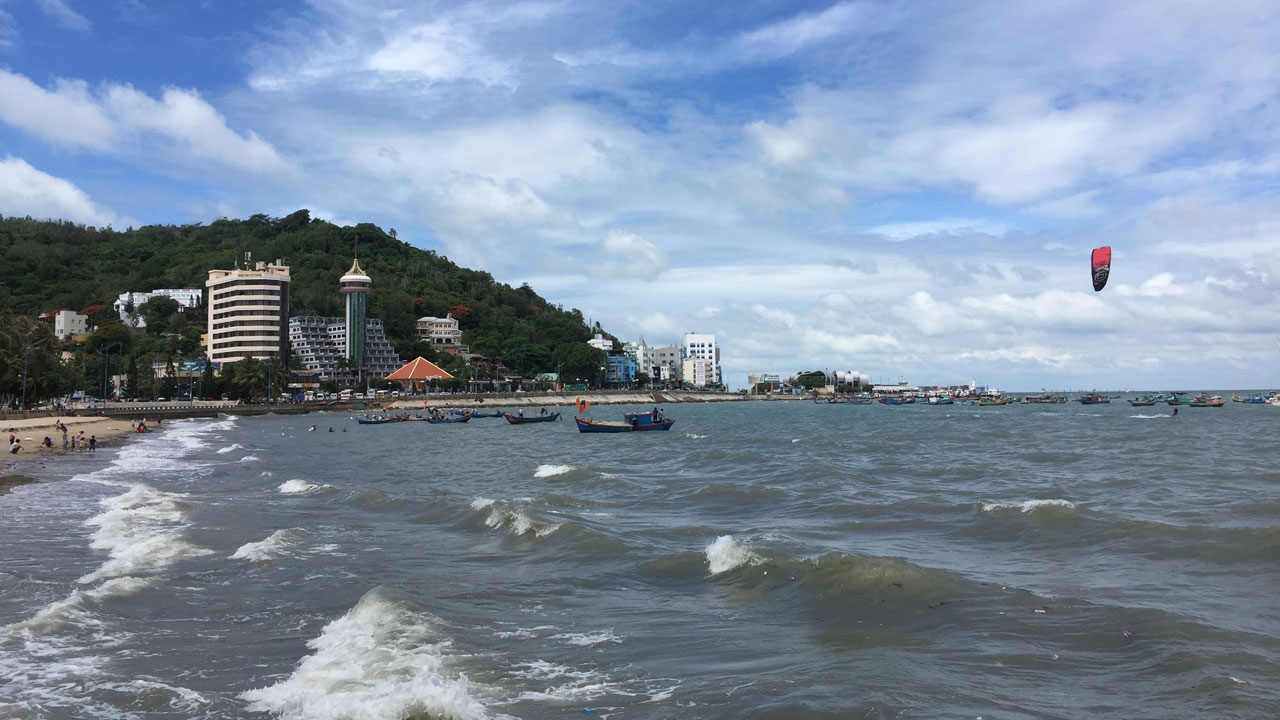After invading a part of Vietnam’s southern territory, the French immediately built several pacification structures, including lighthouses.
First built in 1862 by the French, the Vung Tau lighthouse is the oldest of 79 lighthouses in Vietnam, located 149 meters above sea level. After some restoration and reconstruction at 170 meters above sea level in 1913, the Vung Tau lighthouse looks “newer” in its new white avatar.
The circular lighthouse, 18 meters high, standing atop the Nho Mountain, has emerged as a favorite spot among people visiting Vung Tau. Even the road from Bai Truoc to this spot is already a remarkable “tourist product”. High along the road, one can feel the sea breeze, experience wild landscapes, and peek at the city below from the holes.
The four seasons can truly be felt at this altitude; in spring, the trees bloom and birds chirp, while in summer, there is a flamboyant display of red flowers. In autumn, the frangipani trees often shed leaves, look thinner, but create a romantic impression resembling the setting of a Korean movie. But in winter, the area is best avoided due to heavy rain, cold winds, grey skies and hazy days.
How was it built?
According to documents at the National Archives Center II, Ho Chi Minh City, in the beginning, the French used the Vung Tau lighthouse to guide ships from the large sea to the port of Saigon as well as through the waters of Vung Tau.
As for the construction of the lighthouse, the French recorded the following:
“Today, March twenty-five, one thousand eight hundred and sixty-two, at nine o’clock in the morning, the workmen assigned to the construction of the Cape Saint Jacques lighthouse laid the first stone of the structure.
This stone forms the eastern corner of the second part of the base and contains a lead case which holds: 1) two copies on parchment of the minutes; 2) two gold coins and five silver coins with images of Napoleon III.”
In the past, the French called Vung Tau “Cap Saint Jacques”, from the name given by the Portuguese navigators in the 15th century to this land, when they sailed there en route to Macao.
It is also interesting to read other documents to understand the construction of this lighthouse.
On July 25, 1862, Bonard, the commander of the French forces occupying part of Cochinchine (South of Vietnam nowadays), signed a document referring to the inauguration of the lighthouse. The document specifies that a ship named Forbin will arrive at Cape Saint Jacques on August 15 and fire “a series of twenty-one salvos” on that occasion. At dusk, when the lighthouse is lit, the ship will fire another 21 cannons.
The inauguration of such a lighthouse is quite a solemn affair.
How does it work?
According to regulations on the guarding of lighthouses and beacons along the coasts of Cochinchina signed in advance by Bonard, on May 7, 1862, the Cap Saint Jacques lighthouse had a director and five lighthouse keepers who were soldiers in charge of this task.

The regulations were very detailed, as below:
One hour before sunset, the lighthouse keepers must be on duty all night; however, only one person was awake to keep an eye on the light. This person recorded in a notebook what he observed: the activity of the lighthouse, the lights still in sight, the state of the atmosphere, the ships in sight, etc. In addition, lights that are out or altered also had to be reported. The keeper on duty could call another person if necessary.
The lighthouse keepers should assist mariners and shipwrecked persons; if necessary, help them find shelter.
The light should be turned on 15 minutes after sunset and turned off at dawn. During the day, the lighthouse keepers have to prepare the light for the next night and maintain order at the lighthouse, including keeping it clean.
Tours of the lighthouse were allowed, but only after the staff has finished their morning’s work; tours must conclude at least one hour before sunset. Guests must always be accompanied by lighthouse persons, and were not allowed to enter the engine room. Also, only two guests were allowed to enter the lighthouse area at a time.
Moreover, this regulation mentioned the construction of a second lighthouse in Pulo-Condore, namely Con Dao.
Nowadays, the Vung Tau lighthouse still performs the same task as during the French colonial period and continues the tradition of opening its doors to guests. Before the Covid pandemic, visitors were welcome – there was no need to buy tickets. They could enter, climb to the top of the tower from the spiral staircase at the heart of the lighthouse, zoom off into the distance, look out over the silver sea, or get a close-up view of the sleepy beach town during the week; hectic on the weekend. And of course… take pictures!
Tourists could also enjoy yoghurt and cakes at the Co Tien restaurant just below the lighthouse.









